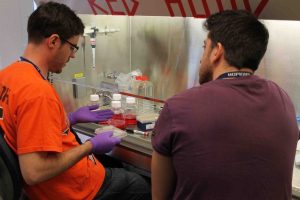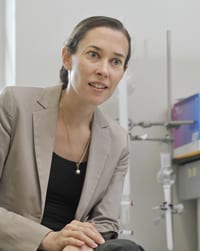For our series on materials scientists turned entrepreneurs and startup founders, we had the pleasure of talking to Jennifer Elisseeff, Professor at Wilmer Eye Institute and Department of Biomedical Engineering at Johns Hopkins University in Baltimore, MD. Among the numerous other hats she wears, such as that of Director of the Translational Tissue Engineering Center, she is the founder of a couple of startups: her most recent venture Aegeria and her previous company Cartilix. Here, we talk with her about research, startups, and how to go from point A to point B, how to make the transition between science and creating a company based on work done in the lab.
Can you give me a brief pitch about what the main product of your current company, Aegeria, is and what is its purpose?
Sure, the current company, Aegeria soft tissue, is working to translate a soft tissue reconstruction material. So, essentially, we are extracting a matrix from adipose tissue and processing it using a lot of standard materials science techniques to create an injectable material for reconstructing soft tissue defects. So, this was funded in the laboratory, by the Department of Defense, for repairing craniofacial injuries in soldiers, and we developed it, characterized it and, when it comes to manufacturing and running clinical trials, that’s when we translated it to the company.
What is your role within the company, and how much are you involved now with the business side of the company?
Well, the company is still at an early stage, so I’m playing a very active role in the company right now, essentially establishing our preliminary manufacturing protocols, and scaling that up, and running our first clinical trials. After that, is when we have to think about partnerships, marketing, sales, things like that, which someone else will be much better in doing that. So, at this early stage I am in a more active role, and then as the company grows I will take on more of an advisory role.
How different do you feel that the role you play within Aegeria is, with respect to having the same job at a large, established company?
The general perspective of small companies is that you do a lot of different things, you have to consider manufacturing, you have to consider regulatory, legal, clinical. You get exposed to all these things much more than you might at a large company.
When did you figure out that there was a good opportunity for commercial exploitation of this discovery?
I would say that we decided that this was something that could really be commercialized relatively early on, because it was relatively early on in the design process, when we’re trying to solve this problem, we’re working closely with clinicians and as we’re developing the solution, and we’re looking at the numbers with respect to clinical needs and how many people can really benefit from the technology, when you really start focusing on the commercialization plan.
How long was the process from the “idea” to the creation of the company?
Well, that’s hard to say because it’s not as if one day this new idea comes, it’s really an evolution of ideas, so it’s really been a couple of years.
The process of IP protection: what restrictions did it place on what you could and could not talk about with colleagues and at conferences, as well as on your scientific publications?
Well, I think particularly being in an academic environment, and even from the perspective of trying to push the technology forward, you know getting your filings finished and getting all that moving forward, so you can talk about it is important, so we need to be able to communicate. Ideas and specific concepts related to the actual manufacturing and commercialization is probably something that you want to talk less with colleagues, but it tends to be less of a scientific or academic topic. I think you can balance academic freedom with commercialization.
As we mentioned, this is not your first company, you started with a different company, called Cartilix. Before starting that venture, did you want to become an entrepreneur?
Well, I often say I grew up that way, because I did my PhD in Bob Langer’s laboratory
Ah, ok
So, when you grow up and you are surrounded by that, it’s definitely a real possibility. But, you know, I think that for me it is also the concept of doing research for a purpose, right? So, I don’t want to write on the introductory paragraph of my NIH grants that
…It could be useful for this or that…
Yeah, and make a laundry list and never actually do anything that could actually impact people. And it’s a little bit tricky because you could imagine continuing your research and perfecting it for a very long time, and saying it’s not quite ready for people. But, particularly when you are in a hospital environment as we are at Johns Hopkins, you need people who need something today.
Even if it’s not perfect.
Right, even if it’s not perfect you can still really help somebody. So even if we don’t have the super-fancy tissue with embryonic stem cells, all the bells and whistles, you can make an impact. Also, as we’ve done this, it has also brought to light the concept that a lot of the times we’re designing in the laboratory a little too far from the real world and, a lot of design parameters that actually make a difference, in the real world, are not always what we though in the laboratory. So, actually, the experience is really helpful in doing a better job.
And perhaps making things in the lab that are not too complicated for the real world, although they look great on paper.
Yeah.
How influential was the environment you were in? Are many startups created around Johns Hopkins University? Were there any key facilities/procedures/initiatives at your university that substantially simplified the process of creating a company?
I would say, at the beginning, when we created the first company, it was quite challenging, and definitely not necessarily supported very much but over time the perspective has really changed, and the need for translational research and having a clinical impact has really changed at Johns Hopkins. While it might be still a little challenging to navigate the various pathways to do that, I would say there has been a real transformation as far as the perspective of the university in really wanting to see translation happen. That’s nice, it’s nice to see.
What is the main change in mindset that starting your own companies brought to you? What is the most important thing you could not have possibly understood had you not participated in the founding of these companies?
Well, I would say, especially for the first, but really each new company, there’s a lot to learn. Being the personalities that we are, interested in science and in learning, it’s fun, because you’re always learning something new, there’s always a challenge that has to be solved, so I would say that’s an exciting part of it. I think similar to what you mentioned before, understanding the challenges, of taking something that you think you’ve made all the proofs of concept and you’ve done everything that needs to be done in the lab: there’s a lot more beyond that to actually get it, not only into people, but really in widespread use.
 Not to mention it takes a while.
Not to mention it takes a while.
Yeah, there’s the time component, but we like to think that the science it the most important thing, right? And the science and engineering, while we like it very much, is only a small component of the whole process of getting something out. You have to have a solid foundation in good science, that’s for sure, But having the best science doesn’t always mean you are going to have the best impact when something goes out. That’s definitely a different mindset.
What advice would you give to someone with a good idea who wants to commercialize it? Or, what would you have done differently?
As far as general advice: getting out and meeting, talking to a lot of people. We’ve done it before. Gathering your information, and understanding the different pathways you could take to do it. Because there are a lot of different ways you can do it, based on how much you’re involved, are you doing a small company, or a larger company. There are a lot of different ways you can move it forward. I would also say, each technology, each company is going to be different in the translation process. Whether they are differences in the IP, the landscape, the manufacturing, difference in clinical trial, regulatory aspects, marketing. They are all different, there’s not a one-size-fits-all for translation. Get as much information as you can, try to work with people you respect, the team you work with is really important too.
One of the scientists we interviewed earlier on in this series on scientists turned entrepreneurs recommended: “get a good lawyer”. Would you agree with that?
(Laughs) Yes, but you have to be careful, because they can be very expensive. There are multiple ways you can go about that, but yes, I definitely did not appreciate this aspect as much as I should have, at the beginning.
How has this changed your interaction with other scientists? (i.e. giving things away for free)
I would say, in the laboratory environment we still give things away for free, we still talk about stuff, and I don’t like looking at a startup company as another research enterprise, in which case people might start being especially secretive. I think the company is really, should be used for, manufacturing and commercialization and, most if not all the science, or as much as possible, should be done before you reach that point of starting the company. I think that helps in many ways: you not only de-risk the technology, and you have better value when you move it out, but you avoid some of those challenges that are, you know, rather un-academic.
How important do you think being an entrepreneur is in today’s academic world?
It depends where you are. There are some universities where it’s really just an add-on and it’s not going to be a part of your tenure process or anything like that. However, many funding agencies around the country want to see an impact of what you’re doing, and I think it can be very difficult for a field, as a whole, if there are not a few good examples of positive impact on society. Similar to what I mentioned before, a lot of times we’re wasting money designing, particularly in engineering laboratories, applied research laboratories, you could be really using the wrong design parameters that could not be relevant in the clinic. So the sooner you have that figured out, and you can start doing things which are relevant to research…
A learning curve.
Yeah. So I think you do better research if you know what’s going to be important in the real world. No matter how well you can model things in the laboratory, outside in the real world, things are always going to be a little different.
Why did you decide to remain also an academic scientist, as opposed to dedicate yourself full-time to one of your startups?
I guess I love the freedom of university and academic research. On one hand, it’s not fully free, because you have to raise the money for what you do. But, as long as you can argue and justify your idea, you have a lot of freedom to try different things. I like to be in a university environment with always new students and new fellows coming through and, over time, you can get involved in a lot of different things.
You can use it to collect ideas that can cross-pollinate…
You can almost look at the laboratory as an incubator and what floats to the top, and has commercial relevance, then can be spun out.
How do you juggle your time between your academic career and your company?
(Laughs) It’s the challenge of time-management, even if you’re just an academic or you’re just an entrepreneur, there’s always going to be a time-management issue. I often read those same articles as I am sure everyone else does that teach you how to be more efficient in your time-management. Balancing work and family, whether you’re an entrepreneur and all that, it’s always going to be a challenge. At different times, it’s going to have different challenges, and you always have to go with it, and make those decisions about prioritizing.
Do you still feel it is important for scientists at a startup company to publish in the open scientific literature, and why?
I would say it really depends on the type of technology. At least for the technologies I am involved in, biomaterials and medical devices, I really would like to see more development going on, in the company, related to manufacturing parameters, release testing parameters. I wouldn’t want to see much new science being done in the company per se, but you’re going to have to do some characterization, to make sure things are similar to what was originally designed, even with manufacturing changes. I’d like to see companies focused on what companies should be really good at, which is the translation process. I’d like to see that kind of development, applied research development, going on in the company. So, I think particularly with clinical trials, it is really important to get out. I doubt that much manufacturing, first of all you probably don’t want that know-how out in the community anyway, so I don’t see quite as much potential for publication, as with the outcomes of clinical testing.
With this we are ending our interview, thank you Jennifer!
Thank you.
And see you in the next installment of our series on materials scientists turned entrepreneurs.

















